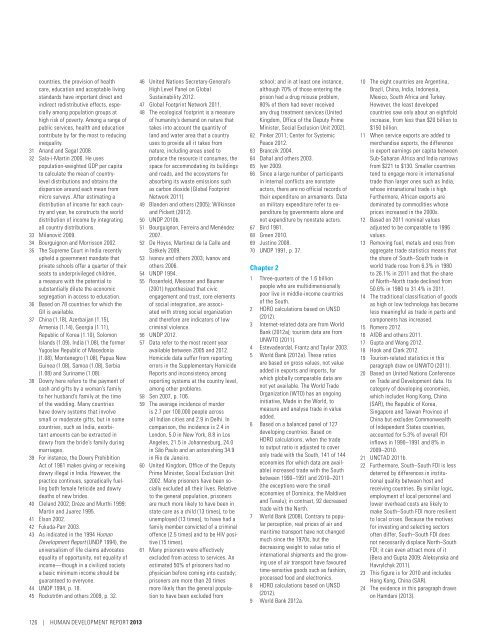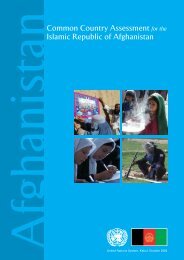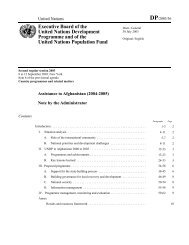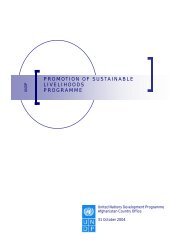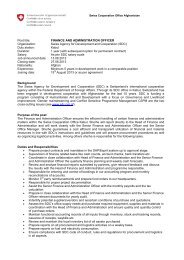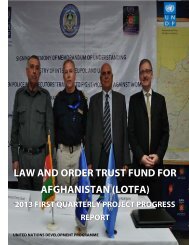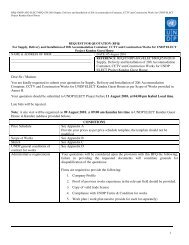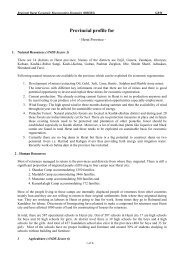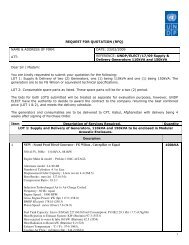E N S W - Human Development Reports - United Nations ...
E N S W - Human Development Reports - United Nations ...
E N S W - Human Development Reports - United Nations ...
You also want an ePaper? Increase the reach of your titles
YUMPU automatically turns print PDFs into web optimized ePapers that Google loves.
countries, the provision of health<br />
care, education and acceptable living<br />
standards have important direct and<br />
indirect redistributive effects, especially<br />
among population groups at<br />
high risk of poverty. Among a range of<br />
public services, health and education<br />
contribute by far the most to reducing<br />
inequality.<br />
31 Anand and Segal 2008.<br />
32 Sala-i-Martin 2006. He uses<br />
population-weighted GDP per capita<br />
to calculate the mean of countrylevel<br />
distributions and obtains the<br />
dispersion around each mean from<br />
micro surveys. After estimating a<br />
distribution of income for each country<br />
and year, he constructs the world<br />
distribution of income by integrating<br />
all country distributions.<br />
33 Milanović 2009.<br />
34 Bourguignon and Morrisson 2002.<br />
35 The Supreme Court in India recently<br />
upheld a government mandate that<br />
private schools offer a quarter of their<br />
seats to underprivileged children,<br />
a measure with the potential to<br />
substantially dilute the economic<br />
segregation in access to education.<br />
36 Based on 78 countries for which the<br />
GII is available.<br />
37 China (1.18), Azerbaijan (1.15),<br />
Armenia (1.14), Georgia (1.11),<br />
Republic of Korea (1.10), Solomon<br />
Islands (1.09), India (1.08), the former<br />
Yugoslav Republic of Macedonia<br />
(1.08), Montenegro (1.08), Papua New<br />
Guinea (1.08), Samoa (1.08), Serbia<br />
(1.08) and Suriname (1.08).<br />
38 Dowry here refers to the payment of<br />
cash and gifts by a woman’s family<br />
to her husband’s family at the time<br />
of the wedding. Many countries<br />
have dowry systems that involve<br />
small or moderate gifts, but in some<br />
countries, such as India, exorbitant<br />
amounts can be extracted in<br />
dowry from the bride’s family during<br />
marriages.<br />
39 For instance, the Dowry Prohibition<br />
Act of 1961 makes giving or receiving<br />
dowry illegal in India. However, the<br />
practice continues, sporadically fuelling<br />
both female feticide and dowry<br />
deaths of new brides.<br />
40 Cleland 2002; Drèze and Murthi 1999;<br />
Martin and Juarez 1995.<br />
41 Elson 2002.<br />
42 Fukuda-Parr 2003.<br />
43 As indicated in the 1994 <strong>Human</strong><br />
<strong>Development</strong> Report (UNDP 1994), the<br />
universalism of life claims advocates<br />
equality of opportunity, not equality of<br />
income—though in a civilized society<br />
a basic minimum income should be<br />
guaranteed to everyone.<br />
44 UNDP 1994, p. 18.<br />
45 Rockström and others 2009, p. 32.<br />
46 <strong>United</strong> <strong>Nations</strong> Secretary-General’s<br />
High Level Panel on Global<br />
Sustainability 2012.<br />
47 Global Footprint Network 2011.<br />
48 The ecological footprint is a measure<br />
of humanity’s demand on nature that<br />
takes into account the quantity of<br />
land and water area that a country<br />
uses to provide all it takes from<br />
nature, including areas used to<br />
produce the resource it consumes, the<br />
space for accommodating its buildings<br />
and roads, and the ecosystems for<br />
absorbing its waste emissions such<br />
as carbon dioxide (Global Footprint<br />
Network 2011).<br />
49 Blanden and others (2005); Wilkinson<br />
and Pickett (2012).<br />
50 UNDP 2010b.<br />
51 Bourguignon, Ferreira and Menéndez<br />
2007.<br />
52 De Hoyos, Martinez de la Calle and<br />
Székely 2009.<br />
53 Ivanov and others 2003; Ivanov and<br />
others 2006.<br />
54 UNDP 1994.<br />
55 Rosenfeld, Messner and Baumer<br />
(2001) hypothesized that civic<br />
engagement and trust, core elements<br />
of social integration, are associated<br />
with strong social organization<br />
and therefore are indicators of low<br />
criminal violence.<br />
56 UNDP 2012.<br />
57 Data refer to the most recent year<br />
available between 2005 and 2012.<br />
Homicide data suffer from reporting<br />
errors in the Supplementary Homicide<br />
<strong>Reports</strong> and inconsistency among<br />
reporting systems at the country level,<br />
among other problems.<br />
58 Sen 2007, p. 106.<br />
59 The average incidence of murder<br />
is 2.7 per 100,000 people across<br />
all Indian cities and 2.9 in Delhi. In<br />
comparison, the incidence is 2.4 in<br />
London, 5.0 in New York, 8.8 in Los<br />
Angeles, 21.5 in Johannesburg, 24.0<br />
in São Paulo and an astonishing 34.9<br />
in Rio de Janeiro.<br />
60 <strong>United</strong> Kingdom, Office of the Deputy<br />
Prime Minister, Social Exclusion Unit<br />
2002. Many prisoners have been socially<br />
excluded all their lives. Relative<br />
to the general population, prisoners<br />
are much more likely to have been in<br />
state care as a child (13 times), to be<br />
unemployed (13 times), to have had a<br />
family member convicted of a criminal<br />
offence (2.5 times) and to be HIV positive<br />
(15 times).<br />
61 Many prisoners were effectively<br />
excluded from access to services. An<br />
estimated 50% of prisoners had no<br />
physician before coming into custody;<br />
prisoners are more than 20 times<br />
more likely than the general population<br />
to have been excluded from<br />
school; and in at least one instance,<br />
although 70% of those entering the<br />
prison had a drug misuse problem,<br />
80% of them had never received<br />
any drug treatment services (<strong>United</strong><br />
Kingdom, Office of the Deputy Prime<br />
Minister, Social Exclusion Unit 2002).<br />
62 Pinker 2011; Center for Systemic<br />
Peace 2012.<br />
63 Branczik 2004.<br />
64 Dahal and others 2003.<br />
65 Iyer 2009.<br />
66 Since a large number of participants<br />
in internal conflicts are nonstate<br />
actors, there are no official records of<br />
their expenditure on armaments. Data<br />
on military expenditure refer to expenditure<br />
by governments alone and<br />
not expenditure by nonstate actors.<br />
67 Bird 1981.<br />
68 Green 2010.<br />
69 Justino 2008.<br />
70 UNDP 1991, p. 37.<br />
Chapter 2<br />
1 Three-quarters of the 1.6 billion<br />
people who are multidimensionally<br />
poor live in middle-income countries<br />
of the South.<br />
2 HDRO calculations based on UNSD<br />
(2012).<br />
3 Internet-related data are from World<br />
Bank (2012a); tourism data are from<br />
UNWTO (2011).<br />
4 Estevadeordal, Frantz and Taylor 2003.<br />
5 World Bank (2012a). These ratios<br />
are based on gross values, not value<br />
added in exports and imports, for<br />
which globally comparable data are<br />
not yet available. The World Trade<br />
Organization (WTO) has an ongoing<br />
initiative, Made in the World, to<br />
measure and analyse trade in value<br />
added.<br />
6 Based on a balanced panel of 127<br />
developing countries. Based on<br />
HDRO calculations, when the trade<br />
to output ratio is adjusted to cover<br />
only trade with the South, 141 of 144<br />
economies (for which data are available)<br />
increased trade with the South<br />
between 1990–1991 and 2010–2011<br />
(the exceptions were the small<br />
economies of Dominica, the Maldives<br />
and Tuvalu); in contrast, 92 decreased<br />
trade with the North.<br />
7 World Bank (2008). Contrary to popular<br />
perception, real prices of air and<br />
maritime transport have not changed<br />
much since the 1970s, but the<br />
decreasing weight to value ratio of<br />
international shipments and the growing<br />
use of air transport have favoured<br />
time-sensitive goods such as fashion,<br />
processed food and electronics.<br />
8 HDRO calculations based on UNSD<br />
(2012).<br />
9 World Bank 2012a.<br />
10 The eight countries are Argentina,<br />
Brazil, China, India, Indonesia,<br />
Mexico, South Africa and Turkey.<br />
However, the least developed<br />
countries saw only about an eightfold<br />
increase, from less than $20 billion to<br />
$150 billion.<br />
11 When service exports are added to<br />
merchandise exports, the difference<br />
in export earnings per capita between<br />
Sub-Saharan Africa and India narrows<br />
from $221 to $130. Smaller countries<br />
tend to engage more in international<br />
trade than larger ones such as India,<br />
whose intranational trade is high.<br />
Furthermore, African exports are<br />
dominated by commodities whose<br />
prices increased in the 2000s.<br />
12 Based on 2011 nominal values<br />
adjusted to be comparable to 1996<br />
values.<br />
13 Removing fuel, metals and ores from<br />
aggregate trade statistics means that<br />
the share of South–South trade in<br />
world trade rose from 6.3% in 1980<br />
to 26.1% in 2011 and that the share<br />
of North–North trade declined from<br />
50.6% in 1980 to 31.4% in 2011.<br />
14 The traditional classification of goods<br />
as high or low technology has become<br />
less meaningful as trade in parts and<br />
components has increased.<br />
15 Romero 2012.<br />
16 AfDB and others 2011.<br />
17 Gupta and Wang 2012.<br />
18 Hook and Clark 2012.<br />
19 Tourism-related statistics in this<br />
paragraph draw on UNWTO (2011).<br />
20 Based on <strong>United</strong> <strong>Nations</strong> Conference<br />
on Trade and <strong>Development</strong> data. Its<br />
category of developing economies,<br />
which includes Hong Kong, China<br />
(SAR), the Republic of Korea,<br />
Singapore and Taiwan Province of<br />
China but excludes Commonwealth<br />
of Independent States countries,<br />
accounted for 5.3% of overall FDI<br />
inflows in 1990–1991 and 8% in<br />
2009–2010.<br />
21 UNCTAD 2011b.<br />
22 Furthermore, South–South FDI is less<br />
deterred by differences in institutional<br />
quality between host and<br />
receiving countries. By similar logic,<br />
employment of local personnel and<br />
lower overhead costs are likely to<br />
make South–South FDI more resilient<br />
to local crises. Because the motives<br />
for investing and selecting sectors<br />
often differ, South–South FDI does<br />
not necessarily displace North–South<br />
FDI; it can even attract more of it<br />
(Bera and Gupta 2009; Aleksynska and<br />
Havrylchyk 2011).<br />
23 This figure is for 2010 and includes<br />
Hong Kong, China (SAR).<br />
24 The evidence in this paragraph draws<br />
on Hamdani (2013).<br />
126 | HUMAN DEVELOPMENT REPORT 2013


